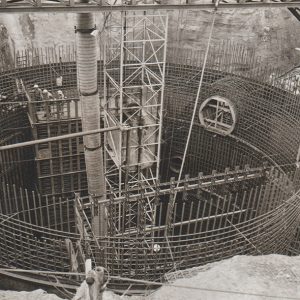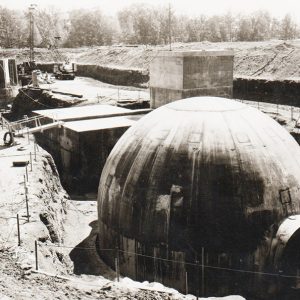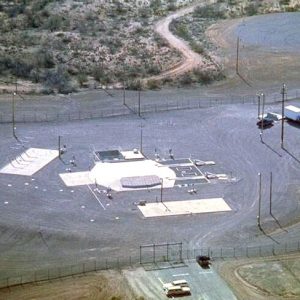calsfoundation@cals.org
Titan II ICBM Launch Complex Sites
Following the Soviet Union’s detonation of its first thermonuclear bomb in 1953, the United States began actively developing an intercontinental ballistic missile (ICBM). Resulting from this was the Titan II Missile program, a Cold War weapons system featuring fifty-four launch complexes in three states. Eighteen were in Arkansas, from which ICBMs carrying nine-megaton nuclear warheads could be launched to strike targets as far as 5,500 miles away. The sites of four Titan II Launch Complexes—373-5 near Center Hill in White County, 374-5 near Springhill in Faulkner County, 374-7 near Southside in Van Buren County, and 373-9 near Vilonia (Faulkner County)—are listed on the National Register of Historic Places.
The Titan II program was part of the second generation of ICBMs, and missiles could be launched from within their silos in less than a minute; first-generation missiles had to be raised from their silos, fueled, and then launched, which could take up to twenty minutes. Deployment of the Titan II missiles was approved by the U.S. Air Force in 1959. Three Strategic Missile Wings (SMWs), each housing two Strategic Missile Squadrons (SMSs) of nine missiles each, were established at Little Rock Air Force Base in Jacksonville (Pulaski County), Davis-Montham Air Force Base in Arizona, and McConnell Air Force Base in Kansas.
The 308th SMW was based at Little Rock Air Force Base and included the 373rd and 374th SMSs. Sites for eighteen Titan II ICBM launch complexes were selected in Faulkner, Conway, White, Van Buren, and Cleburne counties. Construction on the first—Launch Complex 373-4 near Pangburn (White County)—began on January 3, 1961, and the complex became the first in the 308th SMW to be placed on strategic alert, on May 16, 1963, ready to launch its missile at any time. Four-member crews manned each of the 308th’s eighteen launch complexes constantly once they were placed on alert.
On September 24, 1981, the administration of President Ronald Reagan announced plans to retire the Titan II program, citing concerns about safety, a need for cost efficiency, and an evolving nuclear strategy focusing on more modern and precise weapons systems. Destruction of the launch complexes required demolition of the launch ducts in each complex to a depth of some twenty-five feet, followed by excavation of soil around the silo to that depth. After being left open for six months to allow Soviet satellite confirmation of their destruction, the ducts were filled with debris, capped, covered with dirt, and seeded with grass.
The 374th SMS was formally deactivated on August 15, 1986, and its last launch complex, 374-9 near Quitman (Cleburne County), was demolished on November 19, 1986. The final day of operation of the 308th SMW was July 14, 1987, at Launch Complex 373-8 near Judsonia in White County. The 308th SMW and 373rd SMS were formally deactivated on August 18, 1987.
National Register of Historic Places Sites: 373-5, 374-5, 373-9, 374-7
The four National Register–listed Titan II missile launch complexes generally feature concrete pads and earthen mounds reflecting locations of important site features. Extensive underground components from the missile launch complexes also survive. The control center air intake shafts are filled with grout, but intact. The access portals are partially filled with rubble, and the blast lock doors are tack-welded shut. The three-level launch control centers are intact, as are the blast lock areas.
The Titan II ICBM Launch Complex 373-5 Site is located about a half mile east of Highway 320 on Highway 36 near Center Hill in White County. Construction of the complex began on January 3, 1961, and the site was placed on alert on June 15, 1963. Launch Complex 373-5 also was the scene in January 1968 of one of only three military fatalities to befall the 308th SMW in Arkansas; an airman slipped on a hydraulic fluid spill and fell to his death down the launch duct. Launch Complex 373-5 was taken off alert on October 20, 1986, after twenty-three years of service. The site demolition took place on May 1, 1987. The site was listed on the National Register of Historic Places on March 6, 2000.
The Titan II ICBM Launch Complex 374-5 Site is located east of U.S. Highway 65 about a half mile north of its intersection with East Cadron Ridge Road near Springhill in Faulkner County. Construction on the last of the eighteen sites built for the 308thStrategic Missile Wing began on February 15, 1961. The site was placed on alert on December 26, 1963. Launch Complex 374-5 was taken off strategic alert on May 19, 1986, after twenty-two years of service. Site demolition took place on May 1, 1987. The site was listed on the National Register of Historic Places on February 18, 2000.
The Titan II ICBM Launch Complex 373-9 Site is located at 23 Missile Base Road north of Vilonia. The complex was placed on alert on November 15, 1963, and remained active for more than twenty-two years, with its final alert ending on February 6, 1986. Launch Complex 373-9 is unique in Arkansas in that its control center was excavated to be used as the Titan Ranch event center. It was listed on the National Register of Historic Places on September 14, 2020.
The Titan II ICBM Missile Silo 374-7 Site, located west of U.S. 65, 1.7 miles north of intersection with Arkansas Highway 124 near Southside in Van Buren County, is nationally significant by virtue of its unique and exceptionally important history within the Titan II program: it was the site of a September 1980 accident that severely damaged the launch complex, killed an airman, destroyed the rocket, and brought the safety of the entire Titan II program into question. Construction began on January 30, 1961, and the site was placed on alert on December 18, 1963.
Launch Complex 374-7 was involved in two incidents. The first took place on January 27, 1978, when an oxidizer leak released vapors that sent several local citizens to the hospital, though there were no fatalities.
The second incident took place on September 19, 1980. The day before, during a routine oxidizer tank repressurization procedure, a wrench socket was inadvertently dropped from a work platform in the launch duct. After falling approximately eighty feet, it hit the missile thrust mount and bounced in toward the missile, puncturing the first-stage fuel tank. The surrounding civilian population was evacuated late that evening as a precautionary measure. In the early hours of September 19, the accumulated fuel vapors ignited, causing an explosion that destroyed the missile silo. The silo closure door, which weighed 740 tons, was thrown several hundred feet upward and landed about 600 feet northeast of the silo. The W-53 warhead was found damaged but basically intact without a detectable leakage of radioactive material. One person was fatally injured: Senior Airman David Livingston, a member of a two-man propellant transfer team investigating the status of the silo just prior to the explosion.
Launch Complex 374-7 was taken off strategic alert on September 21, 1980, as the result of the explosion. The site was listed on the National Register of Historic Places on February 18, 2000.
For additional information:
Anthony, Michael. “The Sleeping Giant: The Effects of Housing Titan II Missiles in Arkansas and Kansas from 1962 to 1987.” MA thesis, University of Arkansas, 2018. Online at https://scholarworks.uark.edu/etd/2808/ (accessed July 6, 2022).
Cold War Resources Associated with the 308th Strategic Missile Wing in Arkansas Multiple-Property Submission Historic Context. On file at Arkansas Historic Preservation Program, Little Rock, Arkansas.
Schlosser, Eric. Command and Control: Nuclear Weapons, the Damascus Accident, and the Illusion of Safety. New York: Penguin, 2013.
Stumpf, David K. Titan II: A History of a Cold War Missile Program. Fayetteville: University of Arkansas Press, 2000.———. “We Can Neither Confirm Nor Deny.” In Sentinels of History: Reflections on Arkansas Properties on the National Register of Historic Places, edited by Mark K. Christ and Cathryn H. Slater. Fayetteville: University of Arkansas Press, 2000.
“Titan II ICBM Launch Complex 373-5.” National Register of Historic Places nomination form. On file at Arkansas Historic Preservation Program, Little Rock, Arkansas. Online at http://www.arkansaspreservation.com/National-Register-Listings/PDF/WH2346.nr.pdf (accessed October 14, 2021).
“Titan II ICBM Launch Complex 374-5.” National Register of Historic Places nomination form. On file at Arkansas Historic Preservation Program, Little Rock, Arkansas.
“Titan II ICBM Launch Complex 374-7.” National Register of Historic Places nomination form. On file at Arkansas Historic Preservation Program, Little Rock, Arkansas. Online at http://www.arkansaspreservation.com/National-Register-Listings/PDF/VB0050.nr.pdf (accessed October 14, 2021).
Mark K. Christ
Arkansas Historic Preservation Program
 Aviation
Aviation Command and Control
Command and Control Historic Preservation
Historic Preservation World War II through the Faubus Era, 1941 through 1967
World War II through the Faubus Era, 1941 through 1967 Silo Construction
Silo Construction  Silo Construction
Silo Construction  Silo Construction
Silo Construction  Titan II Missile Complex
Titan II Missile Complex 



I was assigned to the 374SMS as a deputy crew commander. I was then elevated to crew commander. I then served as crew commander of the 308SMW crew training unit before then being chosen to serve in the 308SMW safety office as the Wing Weapon Safety Officer and Nuclear Safety Officer. I served those positions until Wing deactivation. I was honored to serve with many outstanding enlisted and officer personnel. After retirement my family and I moved to Vilonia, Arkansas, where we still reside.
I was a Deputy Missile Combat Crew Commander, Missile Combat Crew Commander, Missile Maintenance Officer, and Chief of Maintenance Training Control in the 373rd Strategic Missile Squadron and 308th Strategic Missile Wing 1970-1978. I have fond memories of my time at Little Rock AFB.